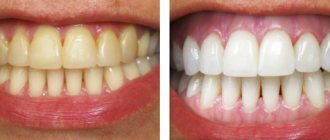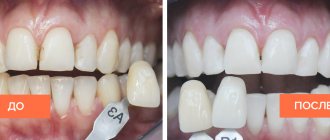Author of the article:
Soldatova Lyudmila Nikolaevna
Candidate of Medical Sciences, Professor of the Department of Clinical Dentistry of the St. Petersburg Medical and Social Institute, Chief Physician of the Alfa-Dent Dental Clinic, St. Petersburg
Teeth whitening is usually contraindicated for pregnant women, this applies to both professional methods and home procedures. It is best to wait until the birth of the child, since whitening is a serious dental procedure based on oxidative processes; the lightening of the enamel is a consequence of the effect of atomic oxygen on its surface. In order to activate the reaction, special compounds are exposed to lasers, lamps, etc.
Dentists say there are ways to safely whiten teeth during pregnancy. So, if you are impatient, you can use this option. We suggest you look into the issue in more detail, find out why bleaching is harmful, what methods are available and what can reduce the negative consequences.
How to whiten teeth: features of the procedure
For professional whitening, special gels based on hydrogen peroxide or carbamide peroxide are used; these active substances act on dental tissue. They change the color of the pigment that is responsible for the color of teeth. In each case, the intensity of whitening depends on the procedure, the composition of the gel and, most importantly, on the natural characteristics of your enamel. Therefore, some will require several procedures, while others will shine with a Hollywood smile after the first one.
Whitening does not disrupt the crystal structure of the tooth, so there is no fear that it will somehow affect the mineral composition of the enamel.
Before you begin the actual whitening process, you should prepare thoroughly. Firstly, it is very important to cure teeth from caries and remove chips. Secondly, it is recommended to carry out professional hygienic cleaning about a week in advance, which will remove plaque and tartar. Depending on the condition of the teeth, preliminary remineralization therapy may be required. Your dentist will prescribe this procedure for you. It must be done a month before bleaching. Remineralization is needed to restore enamel and increase its strength. The procedure helps to avoid gum and tooth disease.
Remember that crowns and fillings will not lighten with bleaching. Therefore, after the procedure, they will stand out noticeably against the background of the snow-white surface of the tooth. Therefore, be prepared that they will have to be replaced. It is best to do this within two or three weeks.
Why are my teeth not white?
A bright Hollywood smile is the dream of many women; of course, everyone wants to look no less impressive than the stars on TV. Thanks to new technologies and growing popularity, it has become available to almost everyone. But do not forget that the color of enamel depends very much on genetics, and, in addition, on eating habits, smoking and many other factors. Because of this, not everyone manages to have beautiful light teeth.
In addition, in fact, a yellowish tint is characteristic of healthy teeth. We owe this to dentin - a light yellow substance that determines the shape of the tooth and is its basis. On top there is a layer of transparent enamel, through which the yellowish tint of dentin shines through.
The layer of dentin on fangs is much thicker than on other teeth, so they are always darker. These features are due to our nature, so you don’t have to worry that your smile does not shine white, since white is an unnatural color for it. But by today's standards, beauty is not always what comes naturally. In addition, progress gives us a wider choice for our own improvement. It should be understood that whitening always weakens the health of teeth, but with proper care this effect is temporary.
By the way, in addition to genetics, your habits also affect the color of your smile. The enamel has a crystalline structure; food pigments accumulate between its rods. Gels extract them from the enamel, allowing you to achieve impressive results.
Home whitening
You can also effectively lighten your crowns at home. It is important that the exposure time of the substance is calculated correctly. Traditional lightening systems include ordinary strips, although they give little effect. Opalescence teeth whitening is a modern option for safe, gentle lightening, but it is used with caution during pregnancy. The technology is recommended for those crowns that have changed color. Advantages of the technique:
- The sticky and viscous gel does not flow out of the trays, which means it cannot harm delicate mucous tissues.
- The result lasts for several years.
- Various formulations and concentrations are available.
- The formula of the substance is patented.
- The result is achieved quickly.
For home treatments, a gel containing 10 to 35 percent carbamide peroxide or 10 percent hydrogen peroxide is recommended. Remember that you should consult a specialist before use. Only after diagnosis can the doctor authorize or prohibit this method. After all, the main thing is the health of the baby and his mother.
Tips for pregnant women when whitening teeth
Pregnancy is a very resource-intensive process for any woman’s body, one of its consequences is weakened gums and teeth. Active bleaching agents can significantly worsen the situation. They not only weaken the enamel even more, but also enter the body of the expectant mother, and this means the child.
At the same time, contraindications are temporary; doctors recommend not to rush and postpone bleaching until the baby is born.
But if you still decide to lighten your enamel, be sure to consult a professional dentist. Do not neglect the advice of a specialist. The dentist will offer you safe procedures that do not disturb the body’s condition and allow you to restore the whiteness of your smile.
Professional teeth cleaning
You can choose a completely safe procedure that, although it will not make your teeth bright white, will allow you to return their natural shade. Professional cleaning removes plaque from your teeth, making your teeth noticeably brighter. This has a positive effect on oral health and is good for your immunity.
Cleaning can be done in several ways. The two most popular are Air Flow and ultrasound.
Air Flow is a special device that delivers a jet of a special composition with abrasive under high pressure. It gently removes soft plaque not only from the surface of the teeth, but also between them. After the procedure, you will notice that your teeth have become lighter and smoother. The procedure lasts approximately half an hour.
Another way is to remove plaque using an ultrasonic device. Using ultrasound it is possible to remove not only soft plaque, but also tartar. This is a more serious effect, so be sure to consult with your supervising physician, especially if it is a question of carrying out the procedure in the first trimesters of pregnancy.
Teeth whitening at home
Professional home whitening systems differ from office whitening systems in having a lower concentration of active substances. Therefore, this type of whitening has a more gentle effect; in order for it to fully manifest itself, you will need to carry out the procedures for about six weeks. With this approach, the action is less aggressive, but in any case you need to consult with your doctor.
The essence of such whitening is that a special gel must be placed in trays, which can be standard or individually made in a dental clinic. The last option will be the best, as it eliminates the leakage of the gel as much as possible.
In addition to trays, you can use other professional whitening methods at home. One of the most inexpensive and fairly effective options is strips with whitening gel. You will get the result after about two months of use, and it will last at least six months. During the procedure, you should stop smoking and eating coloring products.
Onlays for teeth
You want to get absolutely white teeth without risking your health and the health of your child, then your option is veneers. These are special overlays for teeth that allow you not only to change the color, but also to obtain the desired shape of the tooth. It is important to remember that they do not affect the condition of the teeth in any way and are used purely for cosmetic purposes. Before installing them, you should also put your teeth in order: clean them, cure caries and treat your gums. Veneers are one of the most expensive ways to get a Hollywood smile. But perhaps it is worth it, since it is one hundred percent effective and harmless.
Useful tips
It is best to sanitize the oral cavity at the stage of pregnancy planning. If you want to have healthy, snow-white teeth, it will be enough to have professional cleanings twice a year and visit the dentist regularly. Cleaning will return the natural color of teeth without harming the enamel.
Remember that healthy teeth are yellowish in color, and whitening always carries some risks. It is normal for teeth to have a darker color near the gums than at the incisal edge. Such transitions will persist even with chemical bleaching.
If you want to gently lighten your teeth, use ASEPTA PLUS Gentle Whitening paste. It effectively cleans teeth, and the soft abrasives included in its composition lighten the enamel as gently as possible. The paste is approved for use by pregnant women.
A true Hollywood smile with an absolutely even white tone is the result of installing veneers or coponiers.
Why is it important to maintain oral health during pregnancy?
We recommend that expectant mothers take care of the health of their teeth and their beauty even during pregnancy. This recommendation is explained as follows: firstly, there are no contraindications to this, and you should remain beautiful even in later stages. Secondly, after the birth of a child, many people are unable to find a few hours to go to the dentist. And this is not very good, because problems can be caused. We hope we have answered your question about whether it is possible to treat teeth during pregnancy.
Clinical researches
Clinical studies have proven that regular use of professional toothpaste ASEPTA GENTLE WHITENING for a month allows you to lighten tooth enamel by 1.5 tones, increases anti-caries effectiveness by 3.4 times and increases enamel remineralization by 2.6 times.
Sources:
- Report on determining/confirming the preventive properties of toothpaste “ASEPTA PLUS” GENTLE WHITENING” Author: doctor-researcher A.A. Leontyev, head Department of Preventive Dentistry, Doctor of Medical Sciences, Professor S.B. Ulitovsky First St. Petersburg State Medical University named after. acad. I.P. Pavlova, Department of Preventive Dentistry
- Report on the determination/confirmation of the preventive properties of personal oral hygiene products “ASEPTA PLUS” Remineralization doctor-researcher A.A. Leontyev, head Department of Preventive Dentistry, Doctor of Medical Sciences, Professor S.B. Ulitovsky First St. Petersburg State Medical University named after. acad. I.P. Pavlova, Department of Preventive Dentistry
- Clinical studies of antisensitive toothpaste “Asepta Sensitive” (A.A. Leontyev, O.V. Kalinina, S.B. Ulitovsky) A.A. LEONTIEV, dentist O.V. KALININA, dentist S.B. ULITOVSKY, Doctor of Medical Sciences, Prof. Department of Therapeutic Dentistry, St. Petersburg State Medical University named after. acad. I.P. Pavlova
- Report on determining/confirming the preventive properties of toothpaste “ASEPTA PLUS” COFFEE and TOBACCO Author: doctor-researcher A.A. Leontyev, head Department of Preventive Dentistry, Doctor of Medical Sciences, Professor S.B. Ulitovsky. First St. Petersburg State Medical University named after. acad. I.P. Pavlova, Department of Preventive Dentistry
Anesthesia, painkillers and antibiotics
Anesthetics during pregnancy are dangerous because they can penetrate the placenta and also increase blood pressure due to the high content of adrenaline. However, its concentration in a ratio of 1:200,000 has been proven to be safe for both mother and child. It is recommended to use ultracaine and ubistezin as pain-relieving injections during pregnancy. And it is better not to use lidocaine, which is more popular in dentistry, as a “freeze”: it causes cramps and muscle weakness. Also, during pregnancy, anesthesia is strictly prohibited. If complex treatment or tooth extraction cannot be avoided, the doctor may prescribe painkillers to the patient. Ibuprofen and paracetamol are considered the safest during pregnancy, but you need to keep in mind that taking ibuprofen is not recommended in the 3rd trimester. Antibiotics should also be avoided by expectant mothers, but if there is a risk of complications and the development of bacterial infections, drugs from the group of penicillins and cephalosporins are acceptable.
Features and restrictions in the 2nd trimester
The period lasts from 13 to 24 weeks. This is the optimal period for safe dental treatment for pregnant women. The placenta is fully formed, therefore it protects the baby from any negative impact.
The high risk of spontaneous abortion is over, the expectant mother’s well-being has returned to normal, which makes it possible to carry out the necessary procedures. Dental treatment is allowed in the second trimester, including professional cleaning and filling under local anesthesia. The restriction remains relevant: X-rays, bleaching and general anesthesia cannot be performed.
How often do you need to perform the whitening procedure to maintain the effect?
Teeth whitening using chemicals changes the condition of the enamel. Therefore, doctors do not recommend performing it more often than once every 2 years. Between procedures it is recommended:
- For the first month, avoid food and drinks with active dyes - red wine, coffee, brightly colored vegetables.
- Quit smoking - nicotine will quickly return the yellowish tint.
- Visit your doctor regularly to get rid of plaque and tartar.
- Use threads, special pastes, and electric brushes in home care.
Does the procedure have any contraindications?
As with any manipulation in the dental chair, there are contraindications, but not many of them:
- pregnancy and breastfeeding;
- oncological diseases;
- allergies to the drugs used.
All other problems - caries, inflammation of the oral mucosa and gums - are considered relative contraindications. After they are eliminated, bleaching can be done.
Even if you take good care of your teeth, whitening will have the effect of making your smile even more aesthetically pleasing.
Is it allowed to treat teeth during pregnancy?
Of course yes, and sometimes it’s simply necessary. A problematic oral cavity is not only decayed teeth, bad breath and unbearable pain in an inflamed tooth, but primarily the cause of the appearance and spread of infection, which must be prevented and treated at an early stage of pregnancy.
If the situation has already become complicated, the infection will spread throughout the body with pieces of food, saliva and blood. A particularly dangerous situation is when the inflammation is already located near the tooth roots, where blood vessels and bone tissue are located.
Even if during pregnancy a dental infection did not harm either the woman or the child in any way, this can happen after childbirth. After all, every mother loves to kiss and hug her newborn baby, and along with tenderness, the mother passes on her microflora to the child, including a tooth infection. If bacteria enter a child's body that is still fragile after birth, this can lead to many serious problems.
Why do you need to get rid of soft deposits and tartar?
Excess hormones, lack of minerals and vitamins, and impaired metabolism lead to swollen and bleeding gums in pregnant women. Even if pregnancy is absolutely uncomplicated, approximately every fifth woman still experiences gingivitis in the first or second month, an inflammatory disease of the gum tissue.
- Every third pregnant woman notes an increase in the production of saliva, which contributes to the formation of soft plaque on the lower incisors and canines. It is near them in the oral cavity that the excretory ducts of the submandibular salivary glands are located.
- Due to toxicosis, which provokes vomiting, the environment in the oral cavity becomes more acidic. The acidity level is increased by the acid added to the stomach. This destroys tooth enamel and accelerates processes that cause hardening of soft plaque.
- The resulting hard deposits gradually spread downwards, under the gum, causing the formation of dental pockets and peeling of the gum tissue.
If you do not clean the tartar in a timely manner, the gums will turn red and swell, partially covering the dental crowns, become painful and bleed, especially when performing hygiene procedures. An unpleasant odor will settle in the oral cavity. The woman will have difficulty chewing food. Bleeding gums provoke the spread of infection through the bloodstream, which can cause serious harm to the body of the expectant mother and fetus.
How does non-professional whitening affect tooth enamel?
Frequent and uncontrolled use of chemicals for treating teeth leads to the gradual destruction of enamel. It becomes more porous, absorbs dyes faster, becomes cracked and loses its whiteness. The decrease in mineralization of the outer layer and its destruction can be partially compensated with the help of fluorine-containing preparations.
But provided that the whitening procedure is carried out in a dental clinic, in compliance with the recommendations of the attending physician, all risks and negative consequences will be minimized.
We hope that the whitening procedure is now clearer to you and you are ready to achieve a Hollywood smile. Call or sign up on the website:
We also recommend paying attention to the popular service - installation of veneers - snow-white teeth like superstars!










